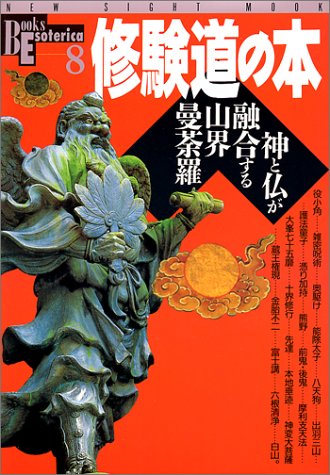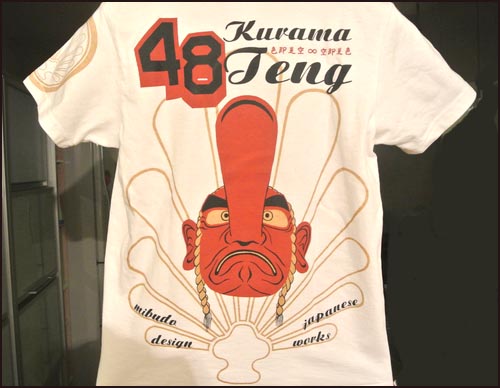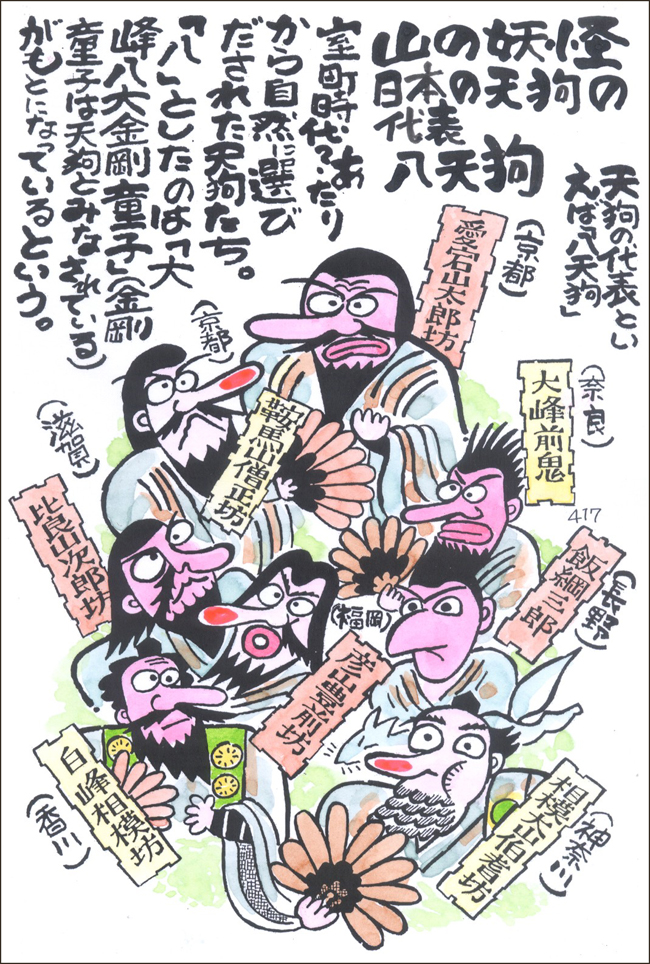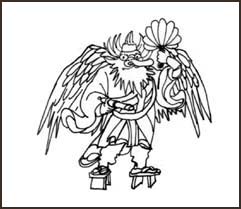. Tengupedia - 天狗ペディア - Tengu ABC-Index .
:::::::::::::::::::::::::::::::::::::::::::::::::::::::::::::::::::::::::::::::::::::::::::::::::::::::::::::::::::::::::::::::::::::::::::::::::::::::::::::::::::::::::::::::::::
四十八天狗 48 Important Tengu of Japan
Each Tengu has a personal name with ... BO 坊 (priest) and also the name of the mountain where he resides.
The mountains of Japan were thought to be the residence of Tengu since ancient times.

修験道の本 ― 神と仏が融合する山界曼荼羅
All Tengu are said to have 翅 wings.
The からすてんぐ Karasu Tengu have a beak like a Garuda bird,
The Tengu from Kuramayama have a 羽団扇 feather fan, a 顔が赤く鼻の高い red face and a long red nose.
The 木葉天狗 / 木の葉天狗 Konoha Tengu wear a Buddhist hood (兜巾 tokin) and band with bells 鈴掛 and a 野袴 rough long pleated Hakama skirt. 野袴
In the Heian period they they were called
Amatsu kitsune, Amatukitsune, Tenko 天狐,天狗 / アマツキツネ Heavenly Foxes.
- - - Tenko (Japanese: 天狐) are a type of divine beast in Japanese folklore. After reaching 1,000 years of age and gaining its ninth tail, a kitsune (fox) turns a golden color, becoming a 'Tenko' (天狐 "heavenly fox"/"celestial fox"), the most powerful form of the kitsune, and then ascends to the heavens. They are able to see a thousand ri ahead. They have nine tails unlike the lower-ranked existences, the yako, the kiko, and the kūko.
- source : wikipedia -
There is even a skull of such an amatsu oomi kitsune アマツオオミキツネ Honorable Tengu with horns.
. Karasutengu, Karasu Tengu 烏天狗、からす天狗 / カラステング
Crow Tengu, Bird Tengu /// kotengu 小天狗 minor Tengu, crow-like goblin .
:::::::::::::::::::::::::::::::::::::::::::::::::::::::::::::::::::::::::::::::::::::::::::::::::::::::::::::::::::::::::::::::::::::::::::::::::::::::::::::::::::::::::::::::::::
四十八天狗 48 Tengu of Japan - ABC
- the order varies according to the source -
. Ajari 阿闍梨坊 Ajari-Bo 肥後阿闍梨 Higo Ajari Kōen 皇円 Saint Koen . - Kumamoto
. 妙高山足立坊 - Ashitatebo (Ashidatebo), Myokosan . - Niigata
. 彦山豊前坊 - Buzenbo, Hikozan . - Fukuoka
. 高良山筑後坊 - Chikugobo, Korazan . - - Fukuoka, Korasan
. 笠置山大僧正 - Daisojo, Kasagizan . - Kasagiyama, Kyoto
. 天岩船檀特坊 / 壇特坊 - Dantokubo, Amanoiwafune . - Osaka
. 富士山陀羅尼坊 - Daranibo, Fujisan - Shizuoka .
- Fujitaro Tengu from Mount Fuji
. 都度沖普賢坊 - Fugenbo, Tsudooki - Shimane .
. 鬼界ヶ島伽藍坊 - Garanbo, Kikaigashima - Kagoshima .
. 常陸筑波法印坊 - Hoinbo, Hitachi 筑波山 Tsukuba (Hidachi) - Ibaraki.
. 石槌山法起坊 - Hokibo Ishizuchizan Ehime .
. 比叡山法性坊 - Hoseibo, Hieizan .
(moved from Kyoto to Gunma to become 妙義大権現 Myogi Daigongen
. 比良山次郎坊 / 二郎坊 / 治朗坊 - Jirobo, Hirasan .
. 越中立山縄乗坊 Josuibo, Etchu Tateyama / Shijo-Bo / ジョウスイボウ .
. 横川覚海坊 - Kakukaibo, Yokogawa (1142 - 1223) - Kyoto (比叡山) .
. 熊野大峯菊丈坊 - Kikujobo, Kumano Omine - Nara .
. 長門普明鬼宿坊 - Kishukubo, Nagato Fumyo - Hiroshima .
. 白髪山高積坊 - Kojobo, Shiragayama - Kochi .
. 象頭山金剛坊 - Kongobo, Zozusan - Kagawa .
. 羽黒山金光坊 - Konkobo, Mount Hagurosan - Yamagata .
- Three Tengu of Hagurosan: 金光坊 Konko-Bo, 三光坊 Sanko-Bo and 円光坊 Enko-Bo
. 浅間ヶ嶽金平坊 - Konpeibo (Konbeibo), Asamagatake - Gunma . - 浅間山
. 黒眷属金比羅坊 - Konpirabo, Kurokenzoku - Kagawa .
. 高野山高林坊 - Korinbo, Korin-Bo, Koyasan - Wakayama .
. 宰府高垣高林坊 / 宰府高垣高森坊 - Korinbo, Saifu Takagaki - Fukuoka .
. 葛城高天坊 - Kotenbo, Katsuragi - Nara .
. 醫王島光徳坊 - Kotokubo, Iogashima - Kagoshima . (硫黄島 Iojima)
. 吉野皆杉小桜坊 - Kozakurabo, Yoshino Minasugi - Nara . - 天狗魔王尊 Tengu Mao Son
. 上野妙義坊 - Myogibo, Ueno . - Gunma
. 妙義山日光坊 - Nikkobo, Myogisan . - Gunma - Tokugawa Ieyasu
. 紫黄山 利久坊 / 利休坊 - Rikyubo, Shiozan . - Ibaraki
. 御嶽山六石坊 - Rokusekibo, Ontakesan, Mitakezan - Nagano (六尺坊 Rokushaku-Bo) .
. 飯綱三郎 - Saburo, Iizuna (Izuna) - Nagano . - - - - Iizuna Gongen 飯綱権現
. 白峯相模坊 / 白峰相模坊 - Sagamibo, Shiramine - Kagawa -
Saganbō Daigongen 相模坊大権現 .
. 厳島三鬼坊 - Sankibo, Itsukushima . - Hiroshima
. 天満山三萬坊 / 天満山三万坊 - Sanmanbo, Tenmanzan . - Gifu
. 秋葉山三尺坊 - Sanshakubo, Akibayama - Shizuoka
- Akiba Gongen 秋葉権現 (Sanjaku-Bo) .
. 新田山佐徳坊 - Satokubo, Nittazan - Gunma .
. 伯耆大山清光坊 - Seikobo, Hoki Daisen / 伯耆坊 Hokibo, Hoki-Bo . - Tottori
. 日向尾畑新蔵坊 - Shinzobo, Hyuga Obatake . - Miyagi
. 鞍馬山僧正坊 - Sojobo, Kuramayama . - Kyoto
. 奈良大久杉坂坊 - Sugisakabo, Nara Ohiza . - Nara
. 高雄内供奉 (たかおないぐぶ) Takao Naigubu . - Kyoto
..... Priest Shinzei 真済 / 柿本僧正 Kakinomoto Sojo / 高雄僧正 Takao Sojo - "Priest with high learning"
. 愛宕山太郎坊 - Tarobo, Atagoyama - Kyoto .
. 日光山東光坊 - Tokobo, Nikkozan - Tokugawa Ieyasu . - Tochigi
. 板遠山頓鈍坊 - Tondonbo, Handazan . - unknown
. 大原住吉剣坊 - Tsurugibo, Ohara Sumiyoshi . - Tottori, Mount Daisen 大山
. 如意ヶ嶽薬師坊 - Yakushibo, Nyoigatake - Kyoto .
. 那智滝本前鬼坊 - Zenkibo, Nachinotakimoto - Nara .
. 大峰山前鬼坊 Zenkibo - Ominesan . - Yoshino, Nara
.......................................................................
There are various spellings in Japanese. Here is another list:
愛宕山太郎坊、妙義山日光坊、比良山次郎坊、常陸筑波法印、鞍馬山僧正坊、英彦山豊前坊、比叡山法性坊、大原住吉剣坊、横川覚海坊、越中立山縄乗坊、富士山陀羅尼坊、天岩船檀特坊、日光山東光坊、奈良大久杉坂坊、羽黒山金光坊、熊野大峰菊丈坊、吉野皆杉小桜坊、天満山三尺坊、那智滝本前鬼坊、厳島三鬼坊、高野山高林坊、白髪山高積坊、新田山佐徳坊、秋葉山三尺坊、鬼界ヶ島伽藍坊、高雄内供奉、板遠山頓鈍坊、飯綱三郎、宰府高桓高森坊、上野妙義坊、長門普明鬼宿坊、肥後阿闍梨、都度沖普賢坊、葛城高天坊、黒眷属金比羅坊、白峰相模坊、日向尾股新蔵坊、高良山筑後坊、医王島光徳坊、象頭山金剛坊、紫尾山利久坊、笠置山大僧正、伯耆大山清光坊、妙高山足立坊、石鎚山法起坊、御嶽山六石坊、如意ヶ岳薬師坊、浅間ヶ岳金平坊、
source : jomon.org/jisho
:::::::::::::::::::::::::::::::::::::::::::::::::::::::::::::::::::::::::::::::::::::::::::::::::::::::::::::::::::::::::::::::::::::::::::::::::::::::::::::::::::::::::::::::::::
- the great Tengu of Japan - 大天狗
- 巨大天狗
- 大天狗になる者
- 大天狗と鼻高天狗
- source : wikipedia

source : komacy.exblog.jp
:::::::::::::::::::::::::::::::::::::::::::::::::::::::::::::::::::::::::::::::::::::::::::::::::::::::::::::::::::::::::::::::::::::::::::::::::::::::::::::::::::::::::::::::::::
日本三大天狗 Three most important Tengu of Japan
Sandai Tengu 三大天狗
愛宕山太郎坊 Atagoyama Tarobo - Kyoto
鞍馬山僧正坊 Kuramayama Shohobo - Kyoto
比良山治朗坊 Hirasan Jirobo - Shiga
- or in other collections:
飯綱三郎 - Saburo, Iizuna (Izuna) - Nagano
高尾山薬王院 Takaozan Yakuo-In, Tokyo
迦葉山弥勒寺 Kashozan, - Gunma Numata - Tenson Keijun 天巽慶順
or Tarobo, Jirobo and Saburobo
. Shiramine Daisoojo 天狗 白峰大僧正 Tengu Shiramine Daisojo .
Taichoo, Taichō 泰澄上人 Saint Taicho Shonin / Taicho-Daishi 泰澄大師 (682 - 767)
Etsu no Daitoku 越の大徳 - Great Man of Virtue from Etsu, Mount Hakusan
Unpen Shoonin 雲遍上人 Saint Unpen Shonin
..............................................................................................................................................
八天狗 Eight Tengu of Japan

source : toki.moo.jp/gaten
愛宕山太郎坊 - Atagoyama Tarobo, Kyoto
鞍馬山僧正坊 Kuramayama Shohobo - Kyoto
比良山治朗坊 Hirasan Jirobo - Shiga
飯綱三郎 Izuna Saburo - Nagano
相模大山伯耆坊 Sagami Oyama Hokibo
彦山豊前坊 Hikozan Buzenbo
大峰前鬼 Omine Zenki
白峰相模坊 Shiramine Sagamibo
大天狗、中天狗、小天狗、烏天狗、水天狗
... 室町時代以降、各地の霊山や力のある山伏集団のいる山では、天狗
に対する崇敬を強め、 ...
- reference : toki.moo.jp/gaten -
The eight Tengu may be a diversion of
the group of Hachibushu, protectors of the Buddhist Law.
仏法を守護する八部衆
One of them is Garuda Ten 迦楼羅天, Karura.
. 八部衆 Group of eight heavenly beings .
. kotowaza ことわざ proverbs with "Tengu" .
koboozu hitori ni tengu hachi nin 小坊主ひとりに天狗八人
”Like a small Kobozu monk facing eight Tengu all by himself.”
:::::::::::::::::::::::::::::::::::::::::::::::::::::::::::::::::::::::::::::::::::::::::::::::::::::::::::::::::::::::::::::::::::::::::::::::::::::::::::::::::::::::::::::::::::
- quote -
Historical Notes.
Tengu mythology was probably introduced to Japan in the 6th or 7th century AD, in conjunction with the arrival of Buddhism from Korea and China. These goblins thereafter appear in Japan’s ancient documents (e.g., from around 720 AD), and are closely associated with Mount Kurama in Japan (near Kibune), the abode of the legendary white-haired Sōjōbō (Sojobo) 僧正坊, King of Tengu.
In Myths and Legends of Japan (1913; by F. Hadland Davis), the Tengu are said to emanate from the primordial Japanese god Susano-o. Tengu lore can be found not just in Buddhist circles, but also among Shinto, Budo, and Ninpo groups. As late as 1860, the Edo Government was posting official notices to the Tengu, asking the goblins to temporarily vacate a certain mountain during a scheduled visit by the Shogun (see Japan and China, by Captain Brinkley). see de Visser’s report.
...
In paintings and woodblock prints, the boar often appears as the steed of the tengu or of their king, Sōjōbō 僧正坊. Sōjōbō is closely linked to famed warrior Minamoto no Yoshitsune 源義経 (1159-1189), one of Japan's most revered samurai. In a well-known legend, Yoshitsune lived among the tengu in his youth and received training in the arts of war from Sōjōbō himself.
Note:
The Buddhist martial deity Marishiten is also often shown riding atop a boar.
Another possible interpretation of the above image relates to the following Zen story: “One day a hunter was in the mountains when he happened to see a snake killing a bird. Suddenly a boar appeared and began to devour the snake. The hunter thought he should kill the boar, but changed his mind because he did not want to be a link in such a chain, and cause his own death by the next predator to come along. On his way home he heard a voice call to him from the top of a tree. It was the voice of a tengu. It told him how lucky he was, for had he killed the boar, the tengu would have killed him. The man subsequently moved into a cave and never killed another animal.”
Sources: A Field Guide to Demons, Fairies, Fallen Angels, and Other Subversive Spirits (by Carol Mack, Dinah Mack) and Animal Motifs in Asian Art: An Illustrated Guide to Their Meanings and Aesthetics (by Katherine M. Ball).
- source : Mark Schumacher -
..............................................................................................................................................
- quote -
tengu 天狗 Lit. celestial dog.
A bird-like goblin frequently encountered in Japanese folk-beliefs, literature and their pictorial depictions. The Japanese demons derive the name from the Chinese mountain god Tiangou 天狗, but also are related to the winged Buddhist deity Garuda. Furthermore, tengu are seen as transformations (keshin 化身) of Shinto deities, yama-no-kami 山の神, mountain guardians often associated with tall trees.
Tengu are of two physical types: karasutengu 烏天狗 identified by a bird's head and beak; and konoha tengu 木の葉天狗 distinguished by a human physique but with wings and a long nose. This type of tengu often carries a feather fan in one hand. Because of its long nose, tengu are associated with the Shinto deity Sarutahiko 猿田彦 who takes on the visage of a monkey, and tengu masks play a prominent role in some religious festivals.
Early Japanese popular tales such as those in the KONJAKU MONOGATARI 今昔物語 (early 12c) portray tengu as enemies of Buddhism, setting fires at temples or tricking priests. Priests who attain special powers through religious discipline, but use these powers for their own ends were thought to enter in the next life the transmigratory realm of tengudou 天狗道.
The earliest representations of tengu are in Kamakura period emaki 絵巻, such as the "Tengu zoushi emaki 天狗草紙絵巻" of 1296 (Nezu 根津 Museum), which criticize arrogant priests who end up becoming tengu.
According to legend, as a boy the famous warrior Minamoto no Yoshitsune 源義経 (1159-89) trained in magical swordsmanship with the tengu king Soujoubou 僧正坊 (Sojobo) near Kuramadera 鞍馬寺 in the mountains north of Kyoto. Tengu frequently are shown in pictures concerning the life of Yoshitsune, including both the Hogen-Heiji 保元平治 battle screens (Metropolitan Museum) and depictions of "Hashi Benkei 橋弁慶" or "Benkei 弁慶 at the Bridge" theme. The Momoyama period daimyo 大名 Kobayakawa Takakage 小早川隆景 (1532-90) supposedly held dialogues with the tengu king Buzenbou 豊前坊 (Buzenbo) on Mt. Hiko 彦.

The character of tengu gradually changed over the centuries.
For instance, tengu were long thought to abduct children, but by the Edo period they often were enlisted to aid in the search for missing children. Similarly, tengu became temple guardians and sculpted images of them were placed on or around temple buildings. Tengu also are associated with yamabushi 山伏 or "mountain ascetics," whose form they often assumed. Tengu often are depicted wearing the yamabushi's distinctive cap and robe. Illustration of tengu increased in popularity and variety during the Edo period, usually reflecting the more positive and even light-hearted conception of the once-ferocious demon. In particular, the long nose of the tengu carried both comic and sexual meaning in ukiyo-e 浮世絵 prints.
- source : JAANUS -
:::::::::::::::::::::::::::::::::::::::::::::::::::::::::::::::::::::::::::::::::::::::::::::::::::::::::::::::::::::::::::::::::::::::::::::::::::::::::::::::::::::::::::::::::::
. - - - Join my Tengupedia friends on facebook ! - - - .
:::::::::::::::::::::::::::::::::::::::::::::::::::::::::::::::::::::::::::::::::::::::::::::::::::::::::::::::::::::::::::::::::::::::::::::::::::::::::::::::::::::::::::::::::::
. - yookai, yōkai 妖怪 Yokai monsters - .
. Tengu 天狗と伝説 Tengu legends "Long-nosed Goblin" .
. Legends and Tales from Japan 伝説 - Introduction .
. Mingei 民芸 Regional Folk Art from Japan .
- #48tengu #bigtengu #importanttengu #tengu48 -
:::::::::::::::::::::::::::::::::::::::::::::::::::::::::::::::::::::::::::::::::::::::::::::::::::::::::::::::::::::::::::::::::::::::::::::::::::::::::::::::::::::::::::::::::::
[ . BACK to DARUMA MUSEUM TOP . ]
[ . BACK to WORLDKIGO . TOP . ]
:::::::::::::::::::::::::::::::::::::::::::::::::::::::::::::::::::::::::::::::::::::::::::::::::::::::::::::::::::::::::::::::::::::::::::::::::::::::::::::::::::::::::::::::::::
No comments:
Post a Comment